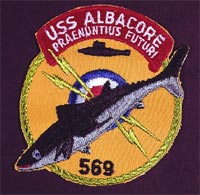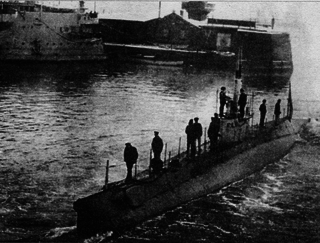Description
Quebec-class submarines were fitted with two regular diesel engines and a third, closed-cycle diesel engine, which used liquid oxygen to provide air-independent propulsion while the submarine was submerged.
The Quebec class had a streamlined conning tower with a fixed snorkel housing at the rear end. They were armed with four torpedo tubes in the bow, for which no reloads were carried, [2] and earlier boats also had a twin 25 mm anti-aircraft gun faired into the forward end of the tower, making them some of the last submarines to be constructed with deck guns.
The Quebec-class was plagued with problems caused by liquid oxygen evaporation. Their endurance was limited to 14 days due to continuous evaporation of the oxygen and lack of a re-liquefaction system, and the propulsion system led to several serious incidents. In 1957 two submarines were lost due to accidents caused by the oxygen system. M-256 suffered a fire off Tallinn in the Baltic, which led to the loss of 35 men, while M-351 sank in the Black Sea with no casualties. Other incidents caused oxygen-fueled flames to burst out from the boats, which led to their crews to nickname them zazhigalka ("lighters") or Zippos after the well-known cigarette lighter.

The Los Angeles class of submarines are nuclear-powered fast attack submarines (SSN) in service with the United States Navy. Also known as the 688 class after the hull number of lead vessel USS Los Angeles (SSN-688), 62 were built from 1972 to 1996, the latter 23 to an improved 688i standard. As of 2022, 26 of the Los Angeles class remain in commission—more than any other class in the world—and they account for more than half of the U.S. Navy's 50 fast attack submarines.

A submarine is a watercraft capable of independent operation underwater. It differs from a submersible, which has more limited underwater capability. The term is also sometimes used historically or colloquially to refer to remotely operated vehicles and robots, as well as medium-sized or smaller vessels, such as the midget submarine and the wet sub. Submarines are referred to as boats rather than ships irrespective of their size.

K-222 was a nuclear-powered cruise-missile submarine built for the Soviet Navy during the Cold War. She was the only ship of the Project 661 Anchar class. Originally named K-18, the submarine was renamed K-162 while still under construction in 1965, and then K-222 in 1978. Commissioned in 1969, the boat was armed with 10 short-range, anti-ship cruise missiles and four torpedo tubes to carry out her mission of destroying American aircraft carriers. The missiles could be fitted with either conventional or nuclear warheads. K-222 was the world's fastest submarine and was the first submarine built with a titanium hull.

A ballistic missile submarine is a submarine capable of deploying submarine-launched ballistic missiles (SLBMs) with nuclear warheads. The United States Navy's hull classification symbols for ballistic missile submarines are SSB and SSBN – the SS denotes submarine, the B denotes ballistic missile, and the N denotes that the submarine is nuclear powered. These submarines became a major weapon system in the Cold War because of their nuclear deterrence capability. They can fire missiles thousands of kilometers from their targets, and acoustic quieting makes them difficult to detect, thus making them a survivable deterrent in the event of a first strike and a key element of the mutual assured destruction policy of nuclear deterrence.

The Type 212A is a class of diesel-electric submarine developed by Howaldtswerke-Deutsche Werft AG (HDW) for the German Navy, and the Italian Navy where it is known as the Todaro class. It features diesel propulsion and an additional air-independent propulsion (AIP) system using Siemens proton exchange membrane (PEM) compressed hydrogen fuel cells. The submarines can operate at high speed on diesel power or switch to the AIP system for silent slow cruising, staying submerged for up to three weeks with little exhaust heat. The system is also said to be vibration-free and virtually undetectable.

USS Albacore (AGSS-569) is a unique research submarine that pioneered the American version of the teardrop hull form of modern submarines. The revolutionary design was derived from extensive hydrodynamic and wind tunnel testing, with an emphasis on underwater speed and maneuverability. She was the third vessel of the United States Navy to be named for the albacore.

The Tang-class submarines were the first submarines designed and built by the United States Navy after WWII. They incorporated the best features of the high-speed German Type XXI U-boat and the venerable U.S. Navy fleet submarine. The Tang-class, with the fleet submarines converted under the Greater Underwater Propulsion Power (GUPPY) program, had much higher submerged performance than their predecessors, but were quickly surpassed by the nuclear-propelled submarines that entered service beginning in 1954. Six units in total were built.

A nuclear submarine is a submarine powered by a nuclear reactor, but not necessarily nuclear-armed. Nuclear submarines have considerable performance advantages over "conventional" submarines. Nuclear propulsion, being completely independent of air, frees the submarine from the need to surface frequently, as is necessary for conventional submarines. The large amount of power generated by a nuclear reactor allows nuclear submarines to operate at high speed for long periods, and the long interval between refuelings grants a range virtually unlimited, making the only limits on voyage times being imposed by such factors as the need to restock food or other consumables.
Air-independent propulsion (AIP), or air-independent power, is any marine propulsion technology that allows a non-nuclear submarine to operate without access to atmospheric oxygen. AIP can augment or replace the diesel-electric propulsion system of non-nuclear vessels.
M-256 was a Project 615 short-range, diesel attack submarine of the Soviet Navy. She was commissioned into the Baltic Fleet.

S-80 was a diesel-electric submarine of the Soviet Navy.

The Gotland-class submarines of the Swedish Navy are modern diesel-electric submarines, which were designed and built by the Kockums shipyard in Sweden. They are the first submarines in the world to feature a Stirling engine air-independent propulsion (AIP) system, which extends their underwater endurance from a few days to weeks. This capability had previously only been available with nuclear-powered submarines.
The history of the submarine spans the entire history of human endeavour as mankind has since early civilisation sought to explore and travel under the sea. Humanity has employed a variety of methods to travel underwater for exploration, recreation, research and significantly, warfare. While early attempts, such as those by Alexander the Great, were rudimentary, the advent of new propulsion systems, fuels, and sonar, propelled an increase in submarine technology. The introduction of the diesel engine, then the nuclear submarine, saw great expansion in submarine use - and specifically military use - during World War I, World War II, and the Cold War. The Second World War use of the U-Boat by the German Navy against the Royal Navy and commercial shipping, and the Cold War's use of submarines by the United States and Russia, helped solidify the submarine's place in popular culture. The latter conflicts also saw an increasing role for the military submarine as a tool of subterfuge, hidden warfare, and nuclear deterrent. The military use of submarines continues to this day, predominantly by North Korea, China, the United States and Russia.

The Type XVII U-boats were small coastal submarines that used a high-test peroxide propulsion system, which offered a combination of air-independent propulsion and high submerged speeds.

Marine propulsion is the mechanism or system used to generate thrust to move a watercraft through water. While paddles and sails are still used on some smaller boats, most modern ships are propelled by mechanical systems consisting of an electric motor or internal combustion engine driving a propeller, or less frequently, in pump-jets, an impeller. Marine engineering is the discipline concerned with the engineering design process of marine propulsion systems.
A teardrop hull is a submarine hull design which emphasizes submerged performance over surfaced performance. It was somewhat commonly used in the early stages of submarine development, but was gradually abandoned in the early 20th century in favour of designs optimized for high performance on the surface as a result of changes in operational doctrine. Although naval doctrine changed, design practices remained until the later parts of World War II when the German Kriegsmarine suffered ever-growing losses of submarines in the Battle of the Atlantic.

A submarine snorkel is a device which allows a submarine to operate submerged while still taking in air from above the surface. British Royal Navy personnel often refer to it as the snort. A concept devised by Dutch engineers, it was widely used on German U-boats during the last year of World War II and known to them as a Schnorchel.
The S-99 experimental submarine was the only ship of the Project 617 class that the Soviet Union built during the early Cold War. She was the only Soviet submarine which used a German Walter turbine fueled by high-test peroxide (HTP). Entering service in 1956, the boat was assigned to a training unit of the Baltic Fleet. S-99 was badly damaged by a HTP explosion in 1959 and was not repaired. The submarine was decommissioned in 1964 and subsequently scrapped.

The Russian submarine AG-11 was an AG-class submarine, designed by the American Holland Torpedo Boat Company/Electric Boat Company, built for the Imperial Russian Navy during World War I. The submarine was fabricated in Canada, shipped to Russia and reassembled for service with the Baltic Fleet.

The Russian submarine AG-22 was an AG-class submarine, designed by the American Holland Torpedo Boat Company/Electric Boat Company, built for the Imperial Russian Navy during World War I. The submarine was fabricated in Canada, shipped to Russia and reassembled for service with the Black Sea Fleet. Her reassembly was completed in 1919 by the White Movement during the Russian Civil War, and she joined Wrangel's fleet as it evacuated the Crimea in 1920 and was interned in Bizerte, Tunisia in 1921. AG-22 was abandoned there and subsequently scrapped.















